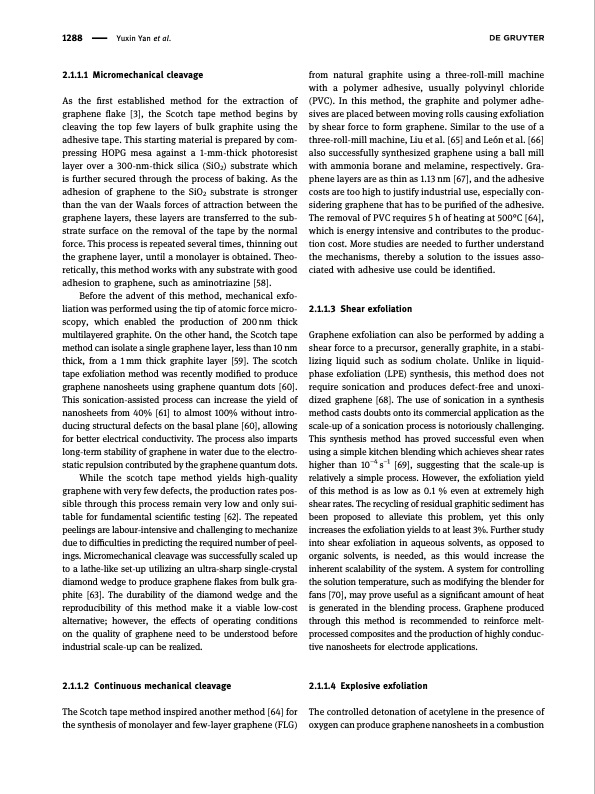
PDF Publication Title:
Text from PDF Page: 005
1288 Yuxin Yan et al. 2.1.1.1 Micromechanical cleavage As the first established method for the extraction of graphene flake [3], the Scotch tape method begins by cleaving the top few layers of bulk graphite using the adhesive tape. This starting material is prepared by com- pressing HOPG mesa against a 1-mm-thick photoresist layer over a 300-nm-thick silica (SiO2) substrate which is further secured through the process of baking. As the adhesion of graphene to the SiO2 substrate is stronger than the van der Waals forces of attraction between the graphene layers, these layers are transferred to the sub- strate surface on the removal of the tape by the normal force. This process is repeated several times, thinning out the graphene layer, until a monolayer is obtained. Theo- retically, this method works with any substrate with good adhesion to graphene, such as aminotriazine [58]. Before the advent of this method, mechanical exfo- liation was performed using the tip of atomic force micro- scopy, which enabled the production of 200nm thick multilayered graphite. On the other hand, the Scotch tape method can isolate a single graphene layer, less than 10 nm thick, from a 1 mm thick graphite layer [59]. The scotch tape exfoliation method was recently modified to produce graphene nanosheets using graphene quantum dots [60]. This sonication-assisted process can increase the yield of nanosheets from 40% [61] to almost 100% without intro- ducing structural defects on the basal plane [60], allowing for better electrical conductivity. The process also imparts long-term stability of graphene in water due to the electro- static repulsion contributed by the graphene quantum dots. While the scotch tape method yields high-quality graphene with very few defects, the production rates pos- sible through this process remain very low and only sui- table for fundamental scientific testing [62]. The repeated peelings are labour-intensive and challenging to mechanize due to difficulties in predicting the required number of peel- ings. Micromechanical cleavage was successfully scaled up to a lathe-like set-up utilizing an ultra-sharp single-crystal diamond wedge to produce graphene flakes from bulk gra- phite [63]. The durability of the diamond wedge and the reproducibility of this method make it a viable low-cost alternative; however, the effects of operating conditions on the quality of graphene need to be understood before industrial scale-up can be realized. 2.1.1.2 Continuous mechanical cleavage The Scotch tape method inspired another method [64] for the synthesis of monolayer and few-layer graphene (FLG) from natural graphite using a three-roll-mill machine with a polymer adhesive, usually polyvinyl chloride (PVC). In this method, the graphite and polymer adhe- sives are placed between moving rolls causing exfoliation by shear force to form graphene. Similar to the use of a three-roll-mill machine, Liu et al. [65] and León et al. [66] also successfully synthesized graphene using a ball mill with ammonia borane and melamine, respectively. Gra- phene layers are as thin as 1.13 nm [67], and the adhesive costs are too high to justify industrial use, especially con- sidering graphene that has to be purified of the adhesive. The removal of PVC requires 5 h of heating at 500°C [64], which is energy intensive and contributes to the produc- tion cost. More studies are needed to further understand the mechanisms, thereby a solution to the issues asso- ciated with adhesive use could be identified. 2.1.1.3 Shear exfoliation Graphene exfoliation can also be performed by adding a shear force to a precursor, generally graphite, in a stabi- lizing liquid such as sodium cholate. Unlike in liquid- phase exfoliation (LPE) synthesis, this method does not require sonication and produces defect-free and unoxi- dized graphene [68]. The use of sonication in a synthesis method casts doubts onto its commercial application as the scale-up of a sonication process is notoriously challenging. This synthesis method has proved successful even when using a simple kitchen blending which achieves shear rates higher than 10−4 s−1 [69], suggesting that the scale-up is relatively a simple process. However, the exfoliation yield of this method is as low as 0.1 % even at extremely high shear rates. The recycling of residual graphitic sediment has been proposed to alleviate this problem, yet this only increases the exfoliation yields to at least 3%. Further study into shear exfoliation in aqueous solvents, as opposed to organic solvents, is needed, as this would increase the inherent scalability of the system. A system for controlling the solution temperature, such as modifying the blender for fans [70], may prove useful as a significant amount of heat is generated in the blending process. Graphene produced through this method is recommended to reinforce melt- processed composites and the production of highly conduc- tive nanosheets for electrode applications. 2.1.1.4 Explosive exfoliation The controlled detonation of acetylene in the presence of oxygen can produce graphene nanosheets in a combustionPDF Image | Synthesis of graphene Potential carbon precursors

PDF Search Title:
Synthesis of graphene Potential carbon precursorsOriginal File Name Searched:
10-1515-ntrev-2020-0100.pdfDIY PDF Search: Google It | Yahoo | Bing
Salgenx Redox Flow Battery Technology: Power up your energy storage game with Salgenx Salt Water Battery. With its advanced technology, the flow battery provides reliable, scalable, and sustainable energy storage for utility-scale projects. Upgrade to a Salgenx flow battery today and take control of your energy future.
| CONTACT TEL: 608-238-6001 Email: greg@infinityturbine.com | RSS | AMP |